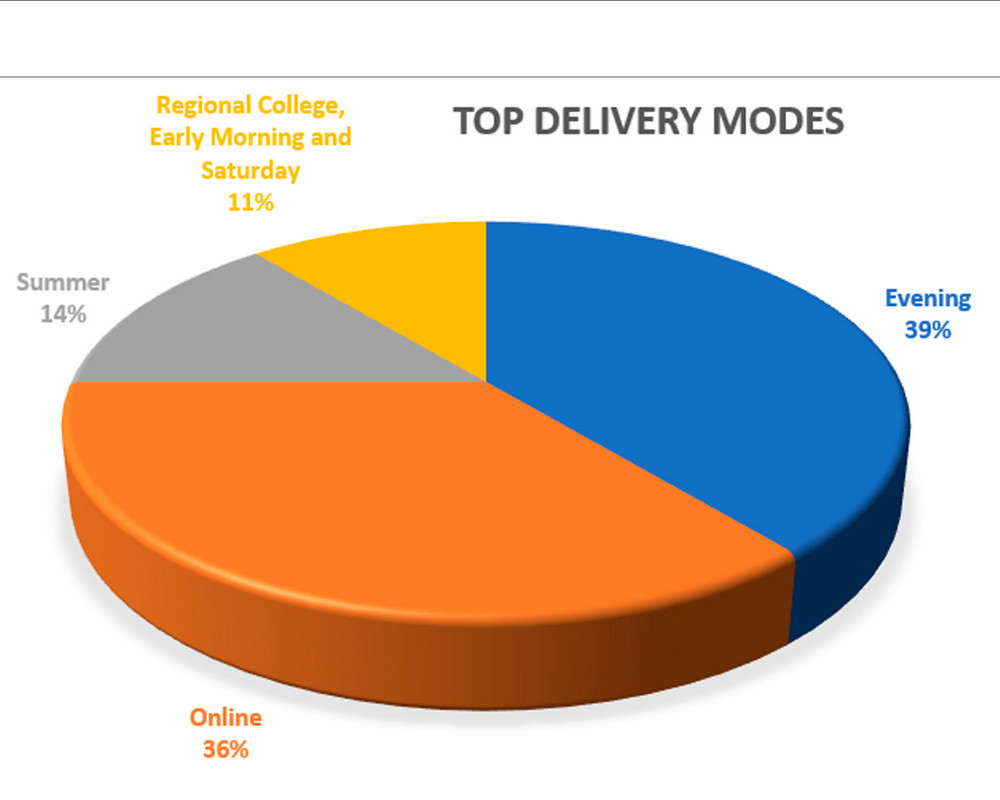
The Innovative Impact of Instructional Design
Accommodating Students and Enhancing Success
“I really didn’t have any idea what instructional design was, and I was also pretty sure I wasn’t interested,” laughingly recalls Paul Sinclair, Associate Professor, at the University of Regina’s Hill School of Business.
It was during the early days of the pandemic that instructors like Sinclair were scrambling to shift their class formats from in-person to online. “When Covid hit, I was one of those people who wanted to recreate the classroom in Zoom but that didn’t seem to be the right way to go.”
When incentives were offered to work with CCE’s instructional design team, Sinclair decided to give it a try. “I had a Business Communications class that I wanted to adapt. I thought they would give me some exercises or tools and send me on my way.”

CCE manages all off-campus and off-hours courses. This graphic shows the percentages of the delivery modes managed by the Centre for Continuing Education.
- Evening 39%
- Online 36%
- Summer 14%
- Regional College, Saturday and Early Morning 11%
Photo credit: University of Regina
Rhett Danyluk, Instructional Designer with CCE, says that Sinclair’s initial perspective on the work that they do is not unique. “The whole experience is about empowering instructors to learn what is possible—what tools are out there, how to use them and how they can make their classes more accessible and engaging for students."
Once U of R faculty work with us and see what we can do together, the gears start turning and it becomes a really collaborative relationship.—Rhett Danyluk, Instructional Designer
One of the surprises for Sinclair was how much he had to learn. “Learning is complicated and when you try to understand the basic functionality of our learning management system there’s a lot to know. That system is the chief interface between students and instructors. What I found fascinating was that even though I started down this path for my online courses, 90% of what we were doing applied to in-person classes, too. It’s really about applying smart design and that helps me to be more effective as a teacher, regardless of the format.”
Danyluk couldn’t agree more. “Most instructors are used to lecturing in front of a class. When they move to a hybrid or online environment they become more of a ‘guide on the side’. Their role is to present the learning material in ways the students can access and review at any time. Students are then able to learn at their own pace and in a way that suits their learning style.”
Indeed, students who are often juggling jobs alongside their education are seeking to engage and learn in different ways.
To accommodate those busy schedules, Danyluk incorporates tools to ensure real-time access. “In lectures, we’ll use interactive materials that allow students to assess themselves whenever it suits their schedule. Students get to practice the material immediately after they’ve learned it and test their knowledge. That’s not something you can easily replicate in the classroom.”He's also created an anonymous feedback tool that allows students to provide comments back to their instructor at any point during a course. “If instructors only get feedback at the end of a course, it’s too late to make changes. Often, it’s a quick fix that’s required so instructors find this ongoing feedback very helpful.”
For Sinclair, the work he’s done with the instructional design team at CCE has had a profound impact on the way he interacts with his students. “I had been discouraged with teaching because I had this sense that students just weren’t engaged,” says Sinclair. “That ‘sage on the stage’ kind of model wasn’t working anymore. I now believe instruction has to be much more thoughtful, targeted and focused. After collaborating with the instructional design team, I’ve been able to rewire my brain. Now I know how to fix the things that don’t make sense or at least who to call if I need help.”

As word spreads, the impact of instructional design has become far-reaching. “Interest in this area is growing,” says Danyluk, “and we work on a diverse range of course content.The learning theory is applicable to every subject and field. When you work with instructors who are excited to learn about these tools and how to make their courses more engaging, it’s very rewarding.”
Learn more about our online and flexible options.
Sinclair, who approached instructional design with some skepticism, is now an advocate. “The instructional design team knew how unenthusiastic I was at the beginning. But now that I’ve worked with them on adapting several courses, I believe that incorporating this type of technology-based learning should be at the very centre of education going forward. There’s a lot to learn so I know I wouldn’t have been able to do it on my own.”
Banner photo credit: University of Regina